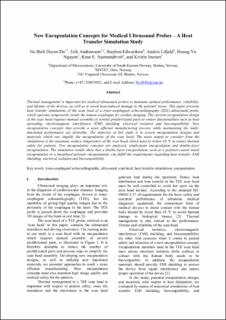| dc.contributor.author | Do, Nu Bich Duyen | |
| dc.contributor.author | Andreassen, Erik | |
| dc.contributor.author | Edwardsen, Stephen | |
| dc.contributor.author | Lifjeld, Anders | |
| dc.contributor.author | Nguyen, Hoang-Vu | |
| dc.contributor.author | Aasmundtveit, Knut | |
| dc.contributor.author | Imenes, Kristin | |
| dc.date.accessioned | 2020-11-17T09:34:27Z | |
| dc.date.available | 2020-11-17T09:34:27Z | |
| dc.date.created | 2020-03-11T12:00:31Z | |
| dc.date.issued | 2019 | |
| dc.identifier.citation | 22nd European Microelectronics and Packaging Conference & Exhibition (EMPC) | en_US |
| dc.identifier.isbn | 978-0-9568086-6-0 | |
| dc.identifier.uri | https://hdl.handle.net/11250/2688159 | |
| dc.description.abstract | Thermal management is important for medical ultrasound probes to maintain optimal performance, reliability, and lifetime of the devices, as well as to avoid heat-induced damage to the patients’ tissue. This paper presents heat transfer simulations of the scan head of a trans-esophageal echocardiography (TEE) ultrasound probe, which operates temporarily inside the human esophagus for cardiac imaging. The current encapsulation design of the scan head requires manual assembly of several prefabricated parts to ensure functionalities such as heat spreading, electromagnetic interference (EMI) shielding, electrical isolation and biocompatibility. New encapsulation concepts that provide a more efficient manufacturing process while maintaining the multi-functional performance are desirable. The objective of this study is to screen encapsulation designs and materials which can simplify the encapsulation of the scan head. The main output to consider from the simulations is the maximum surface temperature of the scan head, which must be below 43 °C to ensure thermal safety for patients. Two encapsulation concepts are analyzed: single-layer encapsulation and double-layer encapsulation. The simulation results show that a double-layer encapsulation, such as a polymer-coated metal encapsulation or a metallized polymer encapsulation, can fulfill the requirements regarding heat transfer, EMI shielding, electrical isolation and biocompatibility. | en_US |
| dc.language.iso | eng | en_US |
| dc.publisher | IEEE | en_US |
| dc.relation.ispartof | 2019 22nd European Microelectronics and Packaging Conference & Exhibition (EMPC) | |
| dc.rights | Attribution-NonCommercial-NoDerivatives 4.0 Internasjonal | * |
| dc.rights.uri | http://creativecommons.org/licenses/by-nc-nd/4.0/deed.no | * |
| dc.subject | encapsulation | en_US |
| dc.subject | heat transfer simulations | en_US |
| dc.subject | ultrasound scan head | en_US |
| dc.subject | trans-esophageal echocardiography | en_US |
| dc.title | New Encapsulation Concepts for Medical Ultrasound Probes – A Heat Transfer Simulation Study | en_US |
| dc.type | Chapter | en_US |
| dc.type | Peer reviewed | en_US |
| dc.description.version | submittedVersion | en_US |
| dc.rights.holder | © 2019 IEEE. Personal use of this material is permitted. Permission from IEEE must be obtained for all other uses, in any current or future media, including reprinting/republishing this material for advertising or promotional purposes, creating new collective works, for resale or redistribution to servers or lists, or reuse of any copyrighted component of this work in other works. | en_US |
| dc.source.pagenumber | 7 | en_US |
| dc.identifier.doi | 10.23919/EMPC44848.2019.8951832 | |
| dc.identifier.cristin | 1801129 | |
| dc.relation.project | Norges forskningsråd: 269618 | en_US |
| dc.relation.project | Norges forskningsråd: 245963 | en_US |
| cristin.unitcode | 7401,80,64,0 | |
| cristin.unitname | Materialer og nanoteknologi | |
| cristin.ispublished | true | |
| cristin.fulltext | preprint | |
| cristin.qualitycode | 1 | |

